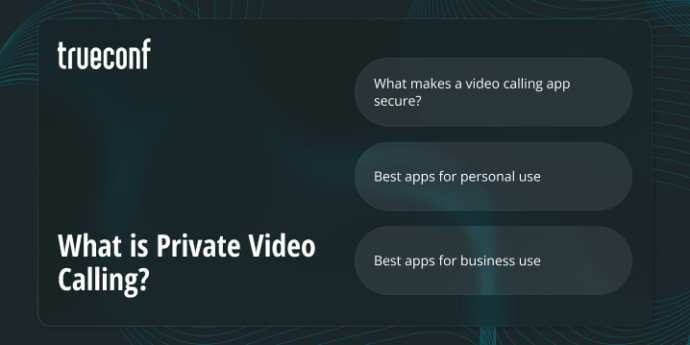Think Your Video Calls Are Private? Meet the Apps That Truly Secure Them

What is Private Video Calling?
A private video call lets you connect safely through a secure, encrypted platform that protects your data and keeps unwanted guests out. As remote work and online meetings have become part of daily life, video calls are now essential — but they’ve also drawn the attention of cybercriminals trying to steal sensitive information.
Privacy isn’t just about keeping secrets — it’s about trust. In business, protecting sensitive data like financial details, client information, or internal strategies helps maintain credibility and prevent costly breaches. Even a single leak during an online meeting can damage a company’s reputation.

For personal communication, privacy ensures that your private moments, opinions, and relationships stay yours alone. Whether you’re catching up with family or discussing health or legal matters, a secure video call gives you the freedom to speak openly without fear of being watched or recorded.
Main Threats of Unsecured Video Calls
- Unauthorized access: Hackers or uninvited guests can join meetings and eavesdrop on private discussions.
- Data interception: Without encryption, video, audio, or shared files can be captured during transmission.
- Phishing and malware attacks: Fake meeting links or malicious attachments can compromise devices and accounts.
- Identity theft: Leaked user details may be exploited to impersonate individuals or gain access to sensitive systems.
What Makes a Video Calling App Secure
When evaluating a video calling platform, it’s not enough to consider usability or call quality — you also need to understand how the service protects your communication. Below are the most important features that define a truly secure and private video calling environment.
1. End-to-End Encryption (E2EE)
End-to-end encryption is the foundation of secure video communication. It ensures that only participants in the conversation can decrypt and view the transmitted data, while no third party — not even the provider — can access the call’s contents.
A reliable platform should use AES-256 encryption, TLS 1.2+, and SRTP for secure signaling and media transport. Ideally, encryption keys are generated and stored locally, preventing exposure to external servers or cloud systems.
2. Strong Authentication and Metadata Protection
Security extends beyond media encryption. Platforms must also protect user identities and metadata — such as connection details and device information.
Essential features include:
- Two-factor authentication (2FA) for user logins
- Single sign-on (SSO) and directory integration (LDAP, Active Directory)
- Role-based access control (RBAC) for managing permissions
- Anonymized or minimal metadata storage to prevent profiling
3. Access Control and Intrusion Prevention
A secure video system must provide flexible tools for controlling who joins and what they can do during a call.
Look for features like:
- Unique meeting IDs and access PINs
- Waiting rooms for host approval before entry
- Automatic meeting lock once all participants have joined
- Permissions for sharing, recording, and inviting others
4. Privacy Compliance and Transparent Policies
Even the most advanced encryption is ineffective if a service mishandles personal data. A trustworthy platform must clearly state how it stores, processes, and deletes user information and comply with international regulations such as GDPR, HIPAA, or ISO/IEC 27001.
Ideally, sensitive communication data should remain under the organization’s direct control, supported by audit logs, data retention settings, and administrative oversight.
5. Local Deployment and Infrastructure Control
For organizations requiring maximum protection, on-premises deployment or private hosting provides the highest level of security. Running the platform within your corporate network ensures that all video, audio, and metadata stay inside your infrastructure.
Top Secure Video Calling Apps in 2025
Best Secure Video Calling Apps for Personal Use
Threema
Security: End-to-end encryption for all calls and messages. No phone number or email is required to register, and all data is stored locally on the user’s device.
Cost: One-time purchase with no subscriptions.
Key Features: Swiss-based service with strong privacy laws, anonymous use, and lightweight app design focused on secure communication only.
Signal
Security: Fully open-source and uses end-to-end encryption by default. Collects virtually no user data and prevents metadata tracking.
Cost: Completely free and supported by donations.
Key Features: Simple interface, cross-platform support, encrypted group calls, and reliability even on slow networks.
Wire
Security: End-to-end encrypted chats and video calls with open-source clients and independent security audits.
Cost: Free personal plan; premium options for teams and enterprises.
Key Features: Modern interface, ability to use on multiple devices at once, and optional self-hosting for advanced users.
Wickr
Security: End-to-end encryption combined with self-destructing messages and secure key exchange. Protects both individual and group video calls.
Cost: Free version for personal use; paid plans for organizations.
Key Features: No phone number needed, messages auto-delete after a set time, and encrypted file sharing for added privacy.
Best Secure Video Calling Apps for Business
TrueConf
Security: Uses end-to-end encryption (AES-256, TLS 1.2+) and allows full on-premises deployment. All media streams and user data stay inside the organization’s network.
Cost: Free version for small teams; paid enterprise editions with advanced admin tools.
Key Features: Works offline, integrates with Active Directory and LDAP, supports role-based access control, recording, and internal chat — ideal for companies requiring full data control.
Cisco Webex
Security: AES-256 encryption, TLS 1.2 transport protection, and optional end-to-end encryption for meetings. Compliance with GDPR, SOC 2, ISO 27001.
Cost: Free plan with time limits; business and enterprise tiers with advanced security management.
Key Features: Scalable cloud infrastructure, identity management, meeting passwords, and host controls suitable for large organizations and government clients.
Pexip
Security: Enterprise-grade encryption, optional on-premises or private cloud hosting, full control of keys and media streams.
Cost: Custom enterprise licensing; trial versions available.
Key Features: High interoperability with SIP/H.323 systems, integration with existing meeting hardware, and compliance with healthcare and government data protection standards.
Microsoft Teams
Security: Encryption in transit and at rest, optional end-to-end encryption for 1:1 calls, and advanced compliance features (GDPR, ISO 27018, HIPAA).
Cost: Included in Microsoft 365 plans; free basic version available.
Key Features: Deep integration with Office apps, multi-factor authentication, policy-based access control, and centralized admin tools for corporate environments.
Take your team communication to the next level with TrueConf!
A powerful self-hosted unified Communications solution for up to 1,000 users, available on desktop, mobile, and room systems.
Future of Secure Video Calling
Evolution of Encryption Technologies and Anonymization
Encryption is becoming more resilient and pervasive. End-to-end encryption (E2EE) is shifting from person-to-person calls to large group environments, thanks to advances like MLS (Message Layer Security) and frame-based encryption in WebRTC. Simultaneously, anonymization techniques are evolving — fewer identifying logs, randomized identifiers, and optional relay routing pad the path for more private communications.
Impact of AI and Quantum Computing on Security
Artificial intelligence is playing a dual role: it strengthens defenses by detecting meeting intrusion, automatically redacting private screens, or identifying deep-fake participants — but it also presents a growing threat. Deep-fakes, voice cloning, and manipulated video streams can undermine trust in video calls. At the same time, quantum computing looms as a future threat to classical encryption algorithms. Organizations must prepare for crypto-agility: hybrid key exchanges, post-quantum algorithms, and flexible key-management systems will be critical.
Forecasts and Trends Through 2030
By 2030, secure video calling will be defined by privacy by design, minimal metadata, control over key-and-data ownership, and the ability to withstand both generational encryption threats and synthetic media attacks.
- Default E2EE for all calls. By 2030, encryption should no longer be optional — it will be enabled by design for 1:1, group, and webinar formats.
- Data sovereignty and local control. More organizations will insist on on-premises or private-cloud deployments, bringing media, keys, and logs back inside their own network boundaries.
- Identity evolution. Authentication will shift to passkeys, DIDs (Decentralized Identifiers), and minimal-data credentials. Guests and external participants will join without surrendering personal data.
- Federated and interoperable environments. Secure video-calling platforms will support interoperable standards and federated networks, enabling high-security calls across different services.
- Combatting synthetic media. Verified media frameworks will emerge, with watermarking, origin metadata, and authenticity tokens built into video call flows.
- Edge analytics, not cloud. Audits, anomaly detection and analytics move to the device or edge, reducing risk of raw media or logs being sent to centralized servers.
About the Author
Nikita Dymenko is a technology writer and business development professional with more than six years of experience in the unified communications industry. Drawing on his background in product management, strategic growth, and business development at TrueConf, Nikita creates insightful articles and reviews about video conferencing platforms, collaboration tools, and enterprise messaging solutions.





Follow us on social networks